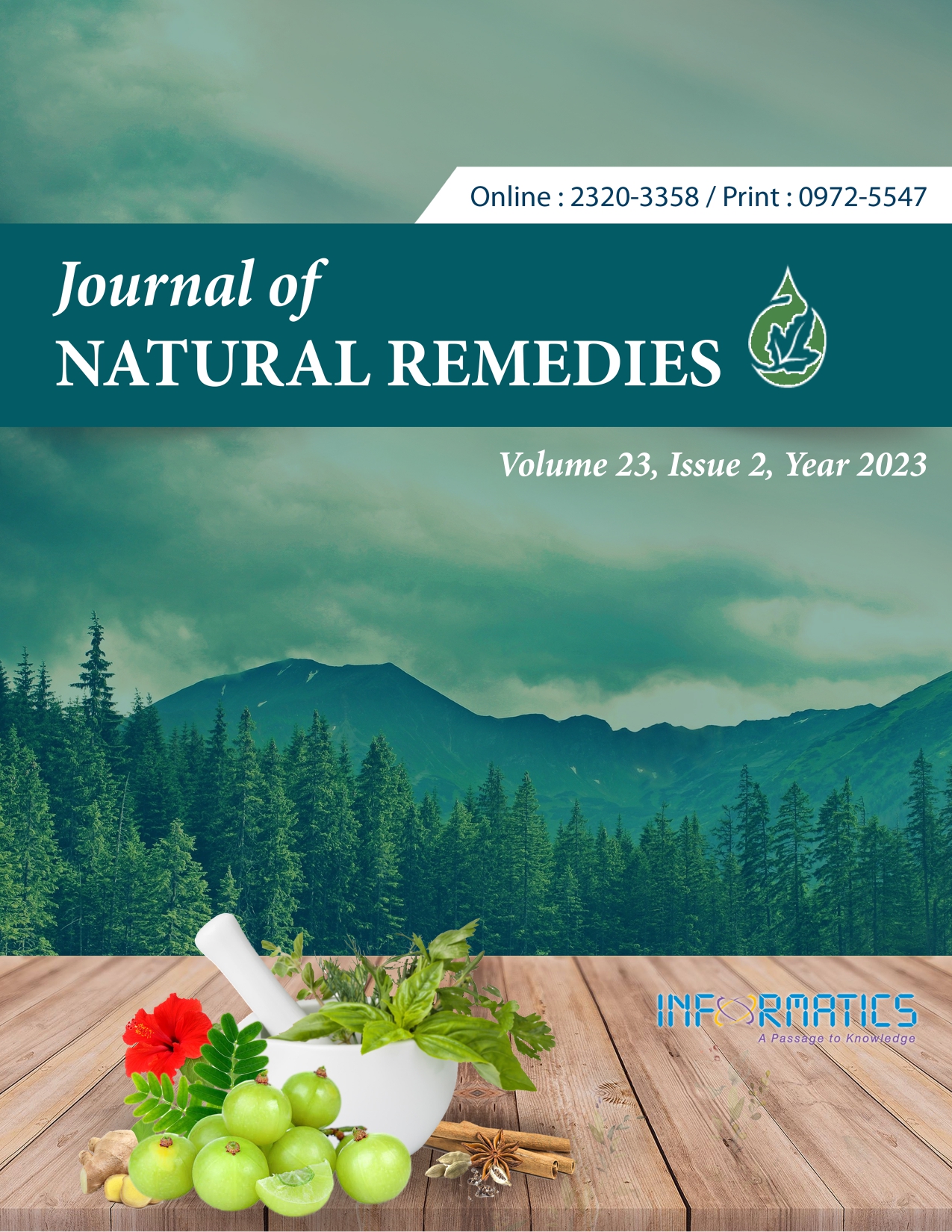Anti-Hepatotoxic Effect of Glinus lotoides Linn. on Rifampicin Induced Liver Impairment in Albino Rats
DOI:
https://doi.org/10.18311/jnr/2023/29029Keywords:
Glinus lotoides Linn., Hepatoprotective Effect, Phytochemical Analysis, Rifampicin, Silymarin, Wister Albino RatsAbstract
Liver ailment is one of the severe health issues all over the sphere. Hepatic damage or failure due to consumption and breathing of hepatotoxin is increasing worldwide. Rifampicin high dosage can cause severe injury to the liver. Today publics wish herbal drugs due to its high efficiency and absence of side effects. Herbal medicines are available for each and every disorder ranging from diabetes to rejuvenators. These facts promoted us to select a medicinal plant Glinus lotoides for the present study which is known as ‘Siruserupadai’ in Tamil. Amid the later ponder, ethanolic extricate was chosen for the anti-hepatotoxicity action; it has maximum numbers of phytoconstituents (Glycosides, saponins, proteins, alkaloids, and flavanoids). Five groups of animals were taken for the test named as control, rifampicin treated group, Silymarin treated group (10 mg/Kg), Ethanolic Extract of Glinus lotoides Linn. (EEGL) treated group (200 mg/Kg), EEGL treated group 400 mg/kg. Rifampicin effectively and particularly ties to RNA polymerase; it represses the amalgamation of all shapes of RNA. It induces fatty liver and finally cirrhosis which is exited by increment the action of serum biological catalysts like SGPT, SGOT and alkaline phosphatase. The hepatoprotective activities was appeared by bringing down the serum biochemical parameters (enzymes and bilirubin) within the rifampicin inebriated rats pre-treated with ethanolic extricate at 200 and 400 mg/kg. The prophylactic impact is reasonably comparable to that of Silymarin, suggesting the EEGL can be potential source of hepatoprotectives.
Downloads
Metrics
Downloads
Published
How to Cite
Issue
Section
License
Copyright (c) 2023 Dr.K.Sudha Rameshwari, P.Arockia selvi

This work is licensed under a Creative Commons Attribution 4.0 International License.
Accepted 2023-04-21
Published 2023-06-13
References
Shaik Salma Suthana, Sai Kiran, Hareesh B. A Review on Herbal Medicines. W. J. Pharm. Biotech. 2018; 5(1):01-07.
Chandran M. FT-IR analysis of methanol extract of leaves of Mollugo lotoides. JETIR. 2015; 2(4):415-424.
Demma, et al. Toxicological study on Glinus lotoides: A traditionally used taenicidal herb in Ethiopia. Journal of Ethnopharmacology. 2007; 111(3):451-457. https://doi.org/10.1016/j.jep.2006.12.017 DOI: https://doi.org/10.1016/j.jep.2006.12.017
Amna Ehlasan Hamad Mohamed. Bioscreening of herbs with putative anti-ulcerogenic activity in rats. [PhD thesis]. 2010. http://khartoumspace.uofk.edu/handle/123456789/8478
Mengesha AE, Youan BB. Anti-cancer activity of extracts of the seed of Glinus lotoides. J Nutri Sci vitaminol (Tokyo). 2010; 56(5):311-8. https://doi.org/10.3177/jnsv.56.311 DOI: https://doi.org/10.3177/jnsv.56.311
K Sudha Rameshwari, et al. Wound healing and antibacterial activities of the chloroform extract of Glinus lotoides Linn. In albino rats. Int J. Pharm. Bio Sci. 2013; 4(4):722-728.
JB Harborne. Phytochemical methods: A guide to modern techniques of plant analysis: Chapman and Hall Ltd., London. 1973; 279-279. https://doi.org/10.1007/978-94-009-5921-7_1 DOI: https://doi.org/10.1007/978-94-009-5921-7_1
Sahira K Banu, Cathrine L. General Techniques Involved in Phytochemical Analysis. International Journal of Advanced Research in Chemical Science. 2015; 2:25-32.
Ahmad Al-Harrasi, Najeeb Ur Rehman, Javid Hussain, Abdul Latif Khan, Ahmed Al-Rawahi, Syed Abdullah Gilani, Mohammed Al-Broumi, Liaqat Ali. Nutritional assessment and antioxidant analysis of 22 date palm (Phoenix dactylifera) varieties growing in Sultanate of Oman. Asian PacJ Trop Med. 2014; 7(1):591-598. https://doi.org/10.1016/S1995-7645(14)60294-7 DOI: https://doi.org/10.1016/S1995-7645(14)60294-7
Kumar H, Bhardwaj K, Nepovimova E, Kamil K, Dhanjal DS, Bhardwaj S, Bhatia SK, Verma R, Kumar D. Antioxidant functionalized nanoparticles: A combat against oxidative stress. Nanomaterials. 2020; 10:1334. [Google Scholar] [CrossRef]. https://doi.org/10.3390/nano10071334 DOI: https://doi.org/10.3390/nano10071334
Abebe Endale, et al. Quantitative determination of the group of flavonoids and saponins from the extracts of the seeds of G. lotoides. Journal of Chromatography. 2005; 1083(1-2): 32-41. https://doi.org/10.1016/j.chroma.2005.05.095 DOI: https://doi.org/10.1016/j.chroma.2005.05.095
Sudha Rameshwari K, Muthu Muneeswari M, Gloria Jemmi Christobel R, Mallika R, Renuka R, Salini R. Synthesis and evaluation of herbal formulation using natural extract. Int. J. Res. Pharm. Sci. 2020; 11(3):3450-3458. https://doi.org/10.26452/ijrps DOI: https://doi.org/10.26452/ijrps.v11i3.2487
Santhosh S, Sini TK, Anandan R, Mathew PT. Hepatoprotective activity of chitosan against isoniazid and rifampicin-induced toxicity in experimental rats. European Journal of Pharmacology. 2007; 572(1):69-73. https://doi.org/10.1016/j.ejphar.2007.05.059 DOI: https://doi.org/10.1016/j.ejphar.2007.05.059
N Delhiraj, MK Jaganathan, AR Vijayakumar. Evaluation of hepatoprotective effect of ethanolic extract of Physali ixocarpa against rifampicin-isoniazid induced hepatotoxicity in wistar rats. Int. Res. J. Pharm. 2020; 11(10):17-22. https://doi.org/10.7897/2230-8407.111085 DOI: https://doi.org/10.7897/2230-8407.111085
Eidelman RA, Lamas GS, Hennerkens CH. The new national education program guidelines. Clinical challenges for more widespread therapy of lipids to treat and prevent coronary heart disease. Achieve of Internal Medicine. 2002; 162(18):2033-2036. https://doi.org/10.1001/archinte.162.18.2033 DOI: https://doi.org/10.1001/archinte.162.18.2033

 K. Sudha Rameshwari
K. Sudha Rameshwari









 0.35
0.35 24
24 0.161
0.161